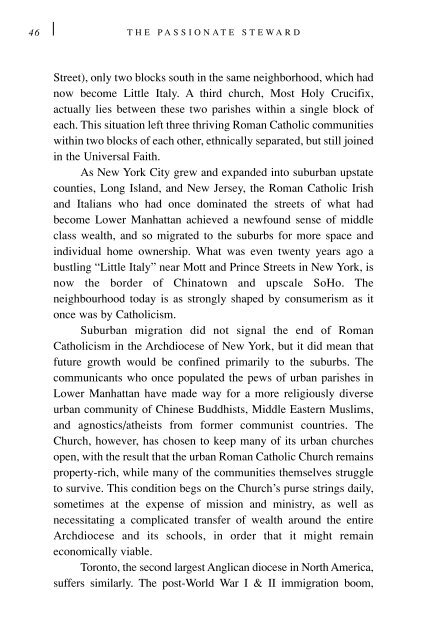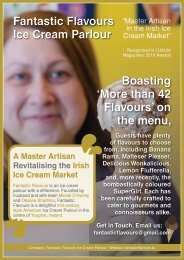Passionate Steward - 10th Anniversary Edition
10th Anniversary Edition of The Passionate Steward - Recovering Christian Stewardship from Secular Fundraising (St. Brigid Press - 2002).
10th Anniversary Edition of The Passionate Steward - Recovering Christian Stewardship from Secular Fundraising (St. Brigid Press - 2002).
Create successful ePaper yourself
Turn your PDF publications into a flip-book with our unique Google optimized e-Paper software.
46 THE PASSIONATE STEWARD<br />
Street), only two blocks south in the same neighborhood, which had<br />
now become Little Italy. A third church, Most Holy Crucifix,<br />
actually lies between these two parishes within a single block of<br />
each. This situation left three thriving Roman Catholic communities<br />
within two blocks of each other, ethnically separated, but still joined<br />
in the Universal Faith.<br />
As New York City grew and expanded into suburban upstate<br />
counties, Long Island, and New Jersey, the Roman Catholic Irish<br />
and Italians who had once dominated the streets of what had<br />
become Lower Manhattan achieved a newfound sense of middle<br />
class wealth, and so migrated to the suburbs for more space and<br />
individual home ownership. What was even twenty years ago a<br />
bustling “Little Italy” near Mott and Prince Streets in New York, is<br />
now the border of Chinatown and upscale SoHo. The<br />
neighbourhood today is as strongly shaped by consumerism as it<br />
once was by Catholicism.<br />
Suburban migration did not signal the end of Roman<br />
Catholicism in the Archdiocese of New York, but it did mean that<br />
future growth would be confined primarily to the suburbs. The<br />
communicants who once populated the pews of urban parishes in<br />
Lower Manhattan have made way for a more religiously diverse<br />
urban community of Chinese Buddhists, Middle Eastern Muslims,<br />
and agnostics/atheists from former communist countries. The<br />
Church, however, has chosen to keep many of its urban churches<br />
open, with the result that the urban Roman Catholic Church remains<br />
property-rich, while many of the communities themselves struggle<br />
to survive. This condition begs on the Church’s purse strings daily,<br />
sometimes at the expense of mission and ministry, as well as<br />
necessitating a complicated transfer of wealth around the entire<br />
Archdiocese and its schools, in order that it might remain<br />
economically viable.<br />
Toronto, the second largest Anglican diocese in North America,<br />
suffers similarly. The post-World War I & II immigration boom,




